Over the last several months, I have been mentally debating the purchase of a concealed carry revolver. This debate began when I realized that the pistol I am carrying, a Glock 43, didn’t have much more capacity than many of the small and lightweight concealed carry revolvers that have come to the market.
The concern about magazine capacity or round count is always an issue among concealed carry holders. There are still many who advocate having as many rounds as possible in the magazine of your concealed carry pistol. I understand their arguments and made those same statements myself for many years.
However, statistically, the average gunfight lasts less than four seconds and involves firing about three rounds. As I have gotten older and comfort has become a more significant part of my everyday lifestyle, carrying a more substantial frame pistol with a double-stack magazine became more of a chore than a comfort.
It occurred to me that the semi-automatic pistol I am regularly carrying has a capacity of six rounds. That is precisely the same amount of rounds that most small revolvers carry when fully loaded. That realization started the thought processes and stirred up my old affinity for wheel guns. I decided that I wanted to shift to the best concealed carry revolver I could find.
I began to think about what I look for in a concealed carry pistol and how a modern revolver stacks up against those criteria. I quickly concluded that a revolver must meet the same essential criteria by which I judge any concealed carry weapon. The best concealed carry revolver should be evaluated on the following 5 criteria:
- Concealability – We are talking about a concealed carry firearm. The ability to conceal your firearm comfortably and easily is the overall goal. Concealability is as valid for a revolver as it is for a semi-automatic pistol. Several factors figure into the concealability of a gun. Overall size is the most significant factor. There is a big difference between concealing a 3-inch snub nose revolver and a 6 inch barreled Dirty Harry style magnum.
- Caliber – If you want to start a real heated conversation among those who carry concealed, ask about the best caliber for a concealed carry gun. There are almost as many calibers as there are opinions about which caliber is the best choice. Caliber is a valid decision. Some calibers may not be appropriate for concealed carry for a variety of reasons.
- Reliability – Reliability issues with modern firearms are usually not an issue. Overall, the quality and materials used in the manufacturing of modern firearms is exceptional. A revolver is inherently simpler than a semi-automatic pistol, which should make them even more reliable in the long run.
- Fit – Fit is a very personal criterion and much more subjective than the first three by which I judge a concealed carry firearm. I want the gun to feel good in my hand. I want the gun to point naturally. It should ride comfortably in the holster. In short, the gun should fit.
- Confidence – All of the above factors should inspire confidence in your abilities. Your confidence in the gun, your abilities, and your training should be supported by the choices you have made.
Qualities of the Best Concealed Carry Revolver
Concealability
The subject of concealability is a bit subjective as well. A petite 105 lbs. woman can conceal a different class of gun than a 250 lbs. man who stands 6ft tall. Some variables also contribute to the size and style of firearm you can conceal easily and comfortably. These variables include:
- Body size
- Body shape
- Wardrobe requirements
- Where you intend to carry
Caliber
Buckle your seat belt. I am sure that my opinions will rock the boat, and many will disagree with my thoughts.
The old conventions of “bigger is better” have been altered by developments in bullet design, powder technology, and new variations on cartridge design. In the past, the concept of more mass in the bullet translated into more knock-down power. Unfortunately, big bullets require big guns that deliver big recoil.
Big also means harder to conceal. To truly be the best concealed carry revolver, the weapon must be concealable. I prefer to put one well-placed round on target rather than 5 or 6 scattered around where I was aiming. Doesn’t it make sense to routine shoot and carry a pistol or revolver that you can manage and with which you are accurate? Caliber makes a big difference. My top picks for caliber for most people who are considering a concealed carry include:
- .357 Magnum – In a revolver, this is a top pick. The .357 delivers a lot of energy for the size of the bullet, and, in the proper revolver, the felt recoil and muzzle flip are manageable.
- .38 Special – The .38 special is the tried and true of the pistol world. It was for many years the go-to round for law enforcement. Its new variants, the +P, and ++P types deliver almost as much energy as the .357.
- 9mm Parabellum – A longtime favorite among those who routinely carry concealed, the 9mm is seeing renewed interest. The advancements in bullet design, loads and powders have given this vintage pistol round a fresh breath of life.
- .380 ACP – The .380 ACP has been known in the past as the 9mm Short. The same innovations in bullet design, powders, and loads have benefited the .380 ACP bringing it back into the list of acceptable self-defense calibers.
Those are my picks for suitable concealed carry calibers for most people. Anything larger than a .357 becomes unwieldy to conceal and, for many people, uncomfortable to shoot. Anything smaller won’t reliably incapacitate a target with multiple well-aimed strikes.
Reliability
If you purchase a brand name revolver from a reputable dealer, reliability shouldn’t be an issue. Functionally, firearms manufactured by well-known and long-standing companies deliver high-quality firearms that should function without much problem.
Reliability issues with most factory fresh firearms and any good firearm purchased from a reputable dealer should have no mechanical issues. There may be issues that come from issues not related to the design or manufacture of the gun.
- Ammunition Feed Issues – This is a problem with some semi-automatic pistols but should never be an issue with a revolver.
- Reload Issues – The means of ejecting and reloading a revolver are vastly different than a semi-automatic pistol. The methods and designs vary but usually involve a cylinder latch, a pivot for the cylinder, and a spent case ejector that may or may not automatically raise or remove the spent cartridges.
- Cleaning and Maintenance – I believe that the chief cause of reliability issues with almost any modern firearm is the lack of care and maintenance that the gun receives. A pistol or revolver carried regularly is exposed to a wide array of contaminants, dust, debris, and other things that can impede the proper operation of the gun.
A gun manufactured by a known company and sold by a licensed dealer should never raise a question of reliability if appropriately maintained by the owner.
Fit
You wouldn’t wear shoes that don’t fit properly. Why would you carry a concealed carry revolver that doesn’t fit? I always urge people who are shopping for guns not to consider the advertising, the caliber, or the company who made the gun. When I was selling guns, I encouraged customers to pick up the firearm, handle it, and feel it.
I would often equip the pistol or concealed carry revolver with a dry fire laser system and allow them to point the gun at a reflective target downrange and experience how the gun pointed, the trigger pull, and the grip. It was fun to watch as some people would grasp a pistol or revolver and you could see the look in their face. When a gun fits, you can feel it, which makes shooting that gun much more enjoyable.
The gun should also fit into your concealed carry system. Some pistols and revolvers don’t work well in some carry positions or with some body types. What looks like a nice feature becomes a source of irritation as it pokes or pinches against you. Try the concealed carry revolver on just the way you intend to carry it. It will be quickly apparent whether it is comfortable to carry.
Confidence
You must be confident in the concealed carry revolver you chose. You may, at some time, place your life on your ability to use that revolver accurately to defend yourself or your family. If you aren’t entirely confident that the gun you have chosen meets your requirements and your needs, it does not belong in your holster.
The time when you need to use that revolver is going to be a seriously intense situation that demands your undivided attention and focus. The last thing you want on your mind is any question about whether the gun will work or if you can shoot it accurately.
The Concealed Carry Revolver as a Choice
Each type of firearm, revolver or semi-automatic, has a set of advantages and disadvantages. Knowing and understanding those differences allows you to make tradeoffs where needed. In the end, it is your confidence, skill, and training that make the big difference in how well your concealed carry revolver or semi-automatic pistol performs under pressure. Let’s look at some of the advantages and disadvantages of concealed carry revolvers as a whole.
Advantages
- Reliability – Barring a major mechanical failure, a revolver has the edge in functional reliability over a semi-automatic pistol. Semi-automatic pistols suffer from two points of potential failure. They depend on a magazine to hold and feed the cartridges to the chamber of the gun. The magazine and the feed mechanism are notorious for malfunctions. Concealed carry revolvers don’t have these built-in failure points, so they get the edge in reliability.
- Simplicity – Revolvers are the epitome of simplicity. Unlike a semi-automatic pistol, there are no magazines, slides, safeties, or buttons. You need only point and pull, and the gun goes bang. Pull again and another bang.
Disadvantages
- Reloading – reloading a revolver under stressful situations is a much more involved task that a semi-automatic pistol. The expended rounds must be cleared from the chambers of the cylinder and then 5 or 6 fresh rounds inserted. It isn’t an impossible task, but it does take practice.
- Malfunctions – A malfunction with a revolver is usually a much more serious issue that takes more than a quick magazine drop, a fresh magazine installed, and a quick pull on the slide to resolve. Most failures or malfunctions in concealed carry revolvers are catastrophic and require more than can be accomplished in the field.
- Limited capacity – The more, the merrier is the old saying. For many concealed carry license holders, that is one of the most significant issues that drive their choice of a firearm. With concealable pistols that can now hold 12 or 15 rounds, these sorts are overjoyed. The knowledge that the average gunfight lasts only 3 seconds and involves only three rounds expended, sort of makes that extra capacity seem like overkill. The trade-off for more rounds at the expense of size and weight is one to be considered.
My Testing Routine
I generally test pistols with a 200 round test firing. For my concealed carry revolver test, I modified that a bit and dropped the round count to 50. The only reason I made this change was the time savings involved. I needed to test all five concealed carry revolvers in one afternoon and running 1000 rounds through 5 or 6 shot revolvers was a major hurdle.
Most of what I shot in these pistols were basic ball ammo. I did put at least five rounds of Hornady Critical Defense .38 special ammunition through each of these revolvers. I usually try a variety of different ammunition in the pistols that I test. Firing self-defense rounds is mainly to check for feed problems, especially with a hollow point or self-defense rounds. Since there are no such problems with a concealed carry revolver, I only put a minimum of this more expensive ammo through the guns.
I shot at a variety of distances from 7 yards to 25 yards using standard silhouette targets. It was a sunny, bright West Texas afternoon with a good breeze blowing across the range. I concluded I needed to do more range testing as soon as I can get a sponsor to provide the guns and the ammo.
I have always liked concealed carry revolvers. They are simple to operate and the lightweight, small frames versions are now available in calibers that make them more than adequate for personal defense. I came up with five small frame revolvers that I wanted to test and perhaps make a purchase as an alternative to the Glock 43 for daily carry.
The five small frame concealed carry revolvers I chose to test are:
- Ruger LCR
- S&W Bodyguard
- S&W 642 airweight
- Rock Island M206
- Taurus 85
My Impression & Review
I must tell you that, overall, I liked shooting all these concealed carry revolvers. They are all well designed and well built, so function and reliability aren’t issues that concern me. My interest is the fit and feel of each of these revolvers in my hand.
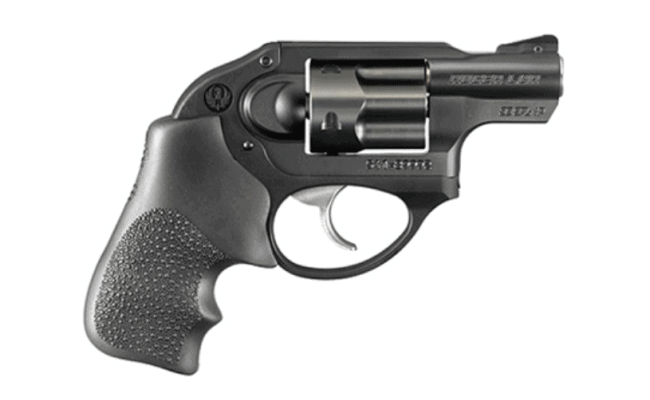
Ruger LCR
The Ruger LCR is by no means a new revolver. The LCR in .38 special has been on the market since 2009 and is a popular revolver with many people. From the beginning, the Ruger LCR was designed as a concealed carry or backup gun and the fundamental technical details reflect that.
- Empty Weight – 13.5 ounces
- Barrel Length – 1.87 inches
- Overall Length – 6.5 inches
- Capacity – 5 rounds
Let me say first that this gun is tiny. The model I test shot was chambered in .357 magnum. I shot .38 special ammo for my test, but the .357 magnum cartridge is a great option for a defense caliber and that option of carrying a .357 magnum self-defense round certainly makes this little revolver attractive.
As I expected, the Ruger LCR performed flawlessly through my test firing. The .38 special round can be quite snappy in the recoil area when shot from a small and lightweight revolver. However, Ruger has made the Hogue rubber grips standard on this revolver. These grips make managing recoil and muzzle flip comfortable.
The Ruger LCR was the last concealed carry revolver I tested, and I had already shot 200 rounds through the other pistols in my test. I will admit that I was feeling the effect in my hands by the time the Ruger came onto the bench. The Hogue grips were a blessing. I managed to keep all 50 rounds inside the seven rings on my target even at 25 yards. That is quite a feat for an old man who is tired, and his hands are tingling.
One thing I am not impressed with on the Ruger LCR is the sights. The front sight is a non-descript ramp style front sight with no highlighting or color and picking it up can be a challenge. On the other hand, this concealed carry revolver will likely be used in close range if a self-defense situation occurs, so sights are probably not the biggest factor. These guns are meant to be more of a “point and shoot” style.
With that said, out of the five revolvers I shot, even being tired, the Ruger LCR had the best fit and feel in my hand. The concealed carry revolver came to target naturally, and the grip angle fit my hand and wrist perfectly. Doing a series of quick on target drills gave me a feeling of confidence that with a little more practice, I could put this gun on target in the dark with little effort.
Price-wise, the Ruger LCR is comparable with other lightweight pistols. In .38 special, the average price across the places I surveyed for the LCR was about $470. If you want the >357 magnum model, expect to pay about $125 more.
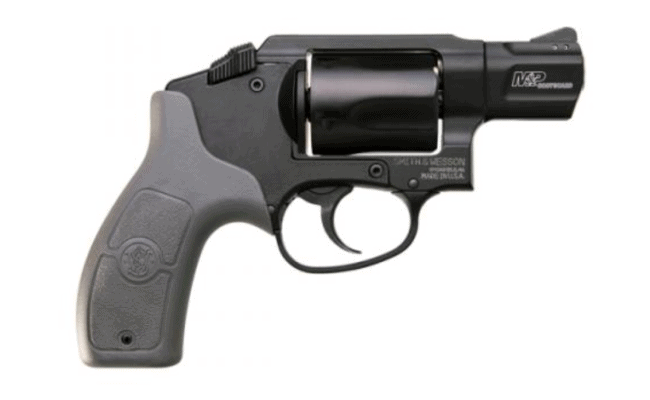
Smith and Wesson Bodyguard 38
Everyone seems enamored with the Smith and Wesson Bodyguard chambered in .380 ACP. Not many concealed carry revolvers chamber the rounds designed for semi-automatic pistols. The downside is my feeling that the .380 ACP is on the low end of the scale for a self-defense firearm, so I opted to shoot the Smith and Wesson Bodyguard chambered in .38 special.
The S&W that I borrowed to test-fire was equipped with the standard offerings from Smith and Wesson, which included:
- Crimson Trace integrated laser
- Pinned black ramp front sight
- Ambidextrous cylinder release
- Synthetic grips
From a technical standpoint, the specs on the Smith and Wesson Bodyguard are comparable to the other concealed carry revolvers in my test:
- Hammerless design
- 1.9-inch barrel
- 6.6 inches overall
- 14.4 ounces empty weight
- Five shot cylinders
There isn’t much not to like about the Smith and Wesson Bodyguard. You get the renowned Smith and Wesson quality and the little gun is sleek with the hammerless design allowing clean smooth draws even from a pocket holster in a pair of tight jeans.
One major difference I found immediately was the placement of the cylinder latch release. On most concealed carry revolvers, this release is a button located on the left side of the frame just at the top of the grips. Smith and Wesson have relocated the latch release to the top of the frame just below the rear sights. This allows for ambidextrous operation, which I found quite nice.
I also like the addition of the Crimson Trace laser into the grip of the revolver. I have never been a big advocate of laser aiming devices, preferring a much more traditional approach to training, and aimed fire. However, in a self-defense situation, when stress is high, I can see the advantage of the laser.
I did shoot about half my test rounds using the laser, and I will admit that it did make a difference in my groupings. That down range visual cue makes bringing the Smith and Wesson Bodyguard on point and on target quick and easy.
From a shooting standpoint, the grips that come standard on the Bodyguard are just ok. They were easy to grip but I wasn’t as comfortable with the revolver as I was with some of the other guns I fired. Looking at the concealed carry revolver, it didn’t appear to me that the grips could be easily changed and, if you did make a change, you would lose the laser.
The grips certainly allowed me to perform with this revolver. Of the 25 or so rounds that I shot without the laser, all but 4 were in the 8-ring even at 25 yards. It took some careful firing but I managed it. With the laser, keeping every shot in the 8-ring was easy and I now understand the attraction for laser aiming devices.
Across the places that I looked, the Smith & Wesson Bodyguard in .38 special came in at about $460, which puts the Bodyguard in the running as a choice for a concealed carry revolver.
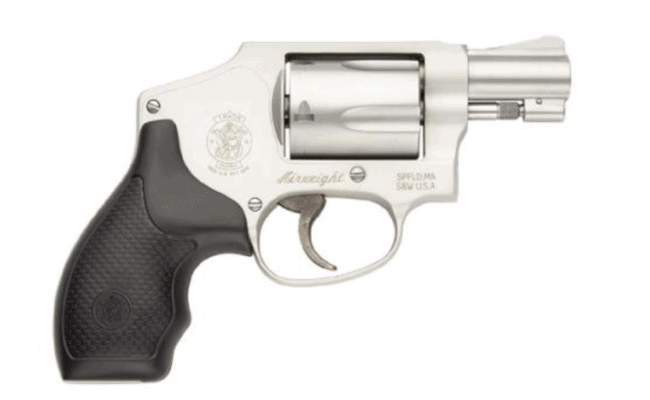
Smith & Wesson 642 Airweight
If you aren’t familiar with the Smith & Wesson J-Frame revolvers, you haven’t spent much time around the pistol world. The J-frame has become the standard of excellence that many shooters use to judge other revolvers. The Smith & Wesson 642 builds on that reputation.
The Model 642 is a truly enclosed hammer revolver. The shooter cannot access the hammer, so only double-action shooting is possible. This may be one feature that some shooters find unacceptable, but if you are going to consider a small frame concealed carry revolver, you must accept that your first shot is going to be made double action.
From a technical perspective, the Smith and Wesson 642 stacks up with all the other revolvers I tested quite nicely.
- Unloaded weight – 14.6-ounces
- Overall Length – 6.3-inches
- Barrel length – 1 7/8 inches
- Five shot cylinders
- Synthetic grips
J-Frame revolvers are some of the easiest revolvers to grip and fire I have found. The Smith and Wesson 642 is no exception and has a great fit and feel in hand. The grips snuggle into the hand and even with moderately large hands, I had no problem maintaining a firm grip on the revolver as it was fired.
There are no surprises with the Model 642. Everything is exactly where you would expect it to be. That is comforting, especially when you are moving back and forth between different firearms for concealed carry.
My one complaint about the Smith and Wesson 642 is the integral front sight. It is true that integral sights on revolvers are standard and they will take a lot of abuse without losing their aimpoint. But the inability to change out for a front sight that is more easily acquired in low light conditions is a problem.
Shooting the Model 642 was easy and comfortable. The .38 special loads didn’t give me any problem with felt recoil or muzzle flip, and the grips made controlling the small frame revolver easy. None of these small and lightweight revolvers are guns I would want to take to the range and put hundreds of rounds through in a single session.
From the standpoint of accuracy, I have no doubt that the Smith & Wesson 642 can shoot better than I am. I was able to consistently print 3-inch groups at 7 yards and 5-inch groups at 25 yards doing slow and carefully aimed fire. The groups widened quite a bit when I shot rapid five-shot double-action rounds.
From a concealed carry revolver standpoint, the enclosed hammer and the sleek non-nonsense design makes this an ideal pocket gun. It is easily concealable and quick to draw when needed. The panel style grips are easily replaceable if you find them hard to handle or need something a bit more substantial to get your hand around.
Looking at the availability of the Smith & Wesson 642 Airweight, I found that the average price to be less than $450. Not a bad deal for an iconic Smith & Wesson Revolver.
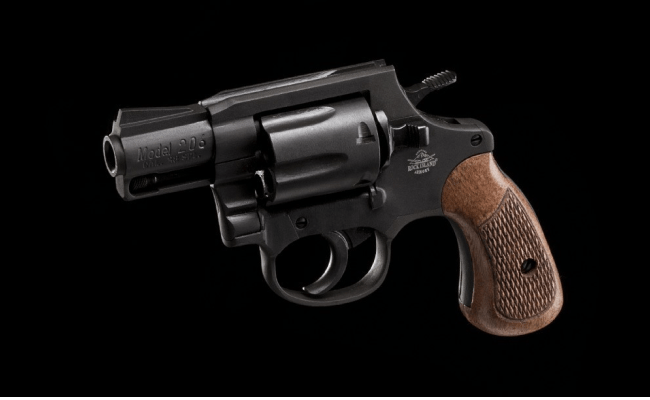
Rock Island M206
I have been a fan of Rock Island guns for a long time. When I had my gun store, I sold Rock Island guns, especially their line of 1911’s. I found that Rock Island built a great gun at a reasonable price and that their customer support was unmatched.
This led me to include the Rock Island M206 revolver in my testing. I wasn’t surprised that the Rock Island M206 didn’t have the same slick fit and finish as some of the other revolvers in my test. Rock Island builds working guns that are meant to be carried, fired, and used. The designs are simple and built to be sturdy and reliable. The Rock Island M206 is no exception.
The Rock Island M206 is right in the mix with the other concealed carry revolvers I tested from a technical perspective.
- Weight unloaded – 25 ounces
- Length overall – 7.75 inches
- Barrel length – 2.15 inches
- Capacity – 6 rounds
That last item is one thing that sets this small frame revolver apart. Most of the other concealed carry revolvers feature a five-shot cylinder. The Rock Island puts six rounds at your disposal for a minimal uptick in size and weight.
The M206 comes from the factory with two sets of grips. The factory configuration is a pair of wood-grained panel grips for the more traditional snub nose look. These grips are smaller, and I found them hard to get a good purchase. After 20 or so rounds, I changed the grips to the factory supply polymer groups with finger indexes. The change was dramatic.
Now I could grip the little pistol and keep better control of the felt recoil and muzzle jump. My hands were certainly grateful, and my patterns improved considerably. The rest of the test firing was a pleasure and I can’t understand why Rock Island just doesn’t put the polymer grips and put the wood panels in the box as a bonus.
Despite its somewhat rough appearance, the Rock Island M206 performed without a problem. Opening the cylinder is smooth and slick. The action and trigger pull feel like that action has been polished. There may be grinding marks on some surfaces, but where it counts, Rock Island has put in the time and the effort to make this a great little gun.
If you are looking for an economical way to have a revolver for a concealed carry alternative, you are going to like the Rock Island M206. The manufacturer’s MSRP on the parkerized version of this revolver is under $300 and if you want a nickel plating, you will come in under $375.
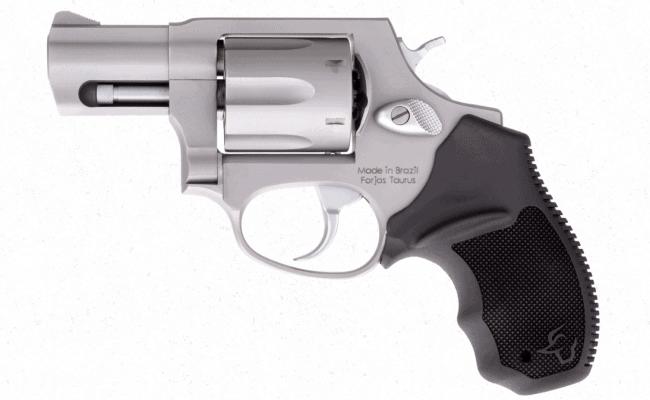
Taurus 85
Taurus gets some bad raps among reviewers, but I have always had good luck with their pistols. I have had Taurus semi-automatics in the past and found them good shooting guns. They seem to fit me well, and I never had some of the problem’s others report. Taurus guns tend to be more economically priced than some other models and that also influenced me to include the Taurus 85 into my test.
There are no surprises in the technical specification department.
- Weight empty – 22.2 ounces
- Barrel Length – 2”
- Overall Length – 6.5”
- Capacity – 5 rounds
- Caliber – 38 special +P
One advantage that the Taurus 85 has is the +P designation. You can safely fire the hotter .38 special loads in this concealed carry revolver. That gives the Taurus 85 one leg up on my list. Another factor that caught my attention was the fact that this little gun is all stainless steel. The matte finish is attractive and there aren’t a lot of tool marks or finishing marks to be found.
From a shooter’s standpoint, the Taurus 85 did well for me. The polymer grips fitted to the stainless steel frame were easy to index in my hand and allowed me to keep excellent control of the recoil and muzzle flip. I didn’t have any +P rounds to put down range but I am convinced that even the most recoil averse shooters could handle the hotter loads in this concealed carry revolver.
As with most modern guns, I am convinced that this revolver can perform better than I am on the range. Groupings were consistently around 3” at 7 yards and 5.5 inches at 25 years. That was done with slow and carefully aimed fire. Rapid-fire seriously diminished my accuracy and that’s all we need to say about that.
As with most of the concealed carry revolvers I tested, I remain underwhelmed by the front sights. The gray matte finish of the front sight of the Taurus 85 seemed to disappear at times when I tried to acquire the sight picture with the target in full sunlight while I was in the shade.
I did notice some stacking of the trigger pull. It wasn’t significant, but it was enough that I noticed. A bit of work on the trigger action could probably eliminate some of the stacking. Other than the stacking, the trigger pull is smooth but a bit long.
On the upside, you can get a Taurus 85 for under $300 with some judicious shopping online. That is not a bad price for a stainless steel frame revolver rated for +P .38 special ammunition.
The Final Verdict
In the end, the Ruger LCR came out on top in my book. The deciding factor was the availability of chambering in .357 magnum. If I want to carry the hotter round, I have that choice with a huge difference in cost. I like having options and the choice of carrying .38 special, +P or .357 gave the Ruger LCR the edge.
If I were shopping strictly on a budget, my choice would have to be the Rock Island M206 or the Taurus 85. Both equally well in the price range and perform admirably on the shooting range. I don’t think you will go wrong with either choice.
Go Forth and Shoot!
If either a semi-automatic or a concealed carry revolver is going to be your weapon of choice, I urge you to do a few things:
- Become Proficient – Selecting a concealed carry class is a great way to start. Online CHP offers this training and testing for free, online.
- Train Effectively and Often – Get range time in whenever possible to keep your skills sharp.
- Carry Responsibly – Concealed carrying is a big responsibility, so treat it as such.
- Carry with Confidence – If you’ve followed the instructions above, you can carry a concealed revolver with full confidence.
I hope that the information and advice in this column help you make the best decision possible about which concealed carry revolver to add to your concealed carry arsenal.


2 thoughts on “The 5 Best Concealed Carry Revolvers: Your Ultimate Guide”
Comments are closed.